Promoting Demolition Waste in Construction Industry in India
VerifiedAdded on 2022/10/10
|36
|8856
|14
Report
AI Summary
This research report focuses on promoting the usage of demolition waste in the construction industry in India, addressing the growing concern of construction and demolition (C&D) waste generation and its impact on environmental sustainability. The study investigates the current waste management practices, the potential sources of solid waste, and the existing systems for C&D waste management in India. It explores the environmental impacts of different waste management methods, including recycling, and aims to determine the most effective strategies for reducing waste. The report includes a literature review of C&D waste management, a discussion of the research methodology, and a case study of a construction and demolition waste management project in Ahmedabad. The findings analyze the effectiveness of material flow analysis in estimating waste amounts and composition, evaluates the market capacity for recycling C&D materials, compares the environmental impacts of various management methods, and determines the amount of concrete debris generated. Ultimately, the report offers conclusions, recommendations, and academic contributions to promote sustainable construction practices and reduce environmental impact in the Indian construction industry.
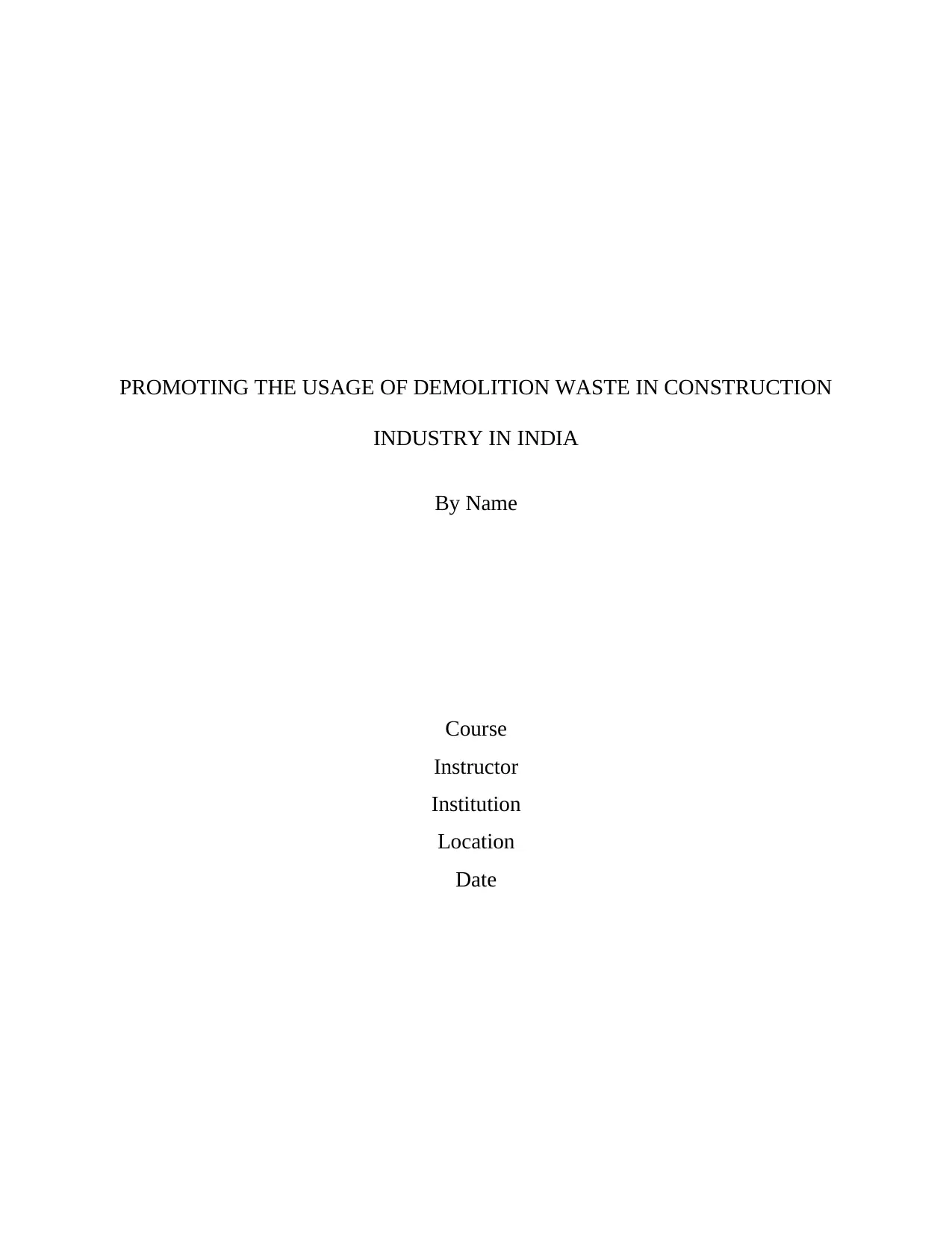
PROMOTING THE USAGE OF DEMOLITION WASTE IN CONSTRUCTION
INDUSTRY IN INDIA
By Name
Course
Instructor
Institution
Location
Date
INDUSTRY IN INDIA
By Name
Course
Instructor
Institution
Location
Date
Paraphrase This Document
Need a fresh take? Get an instant paraphrase of this document with our AI Paraphraser
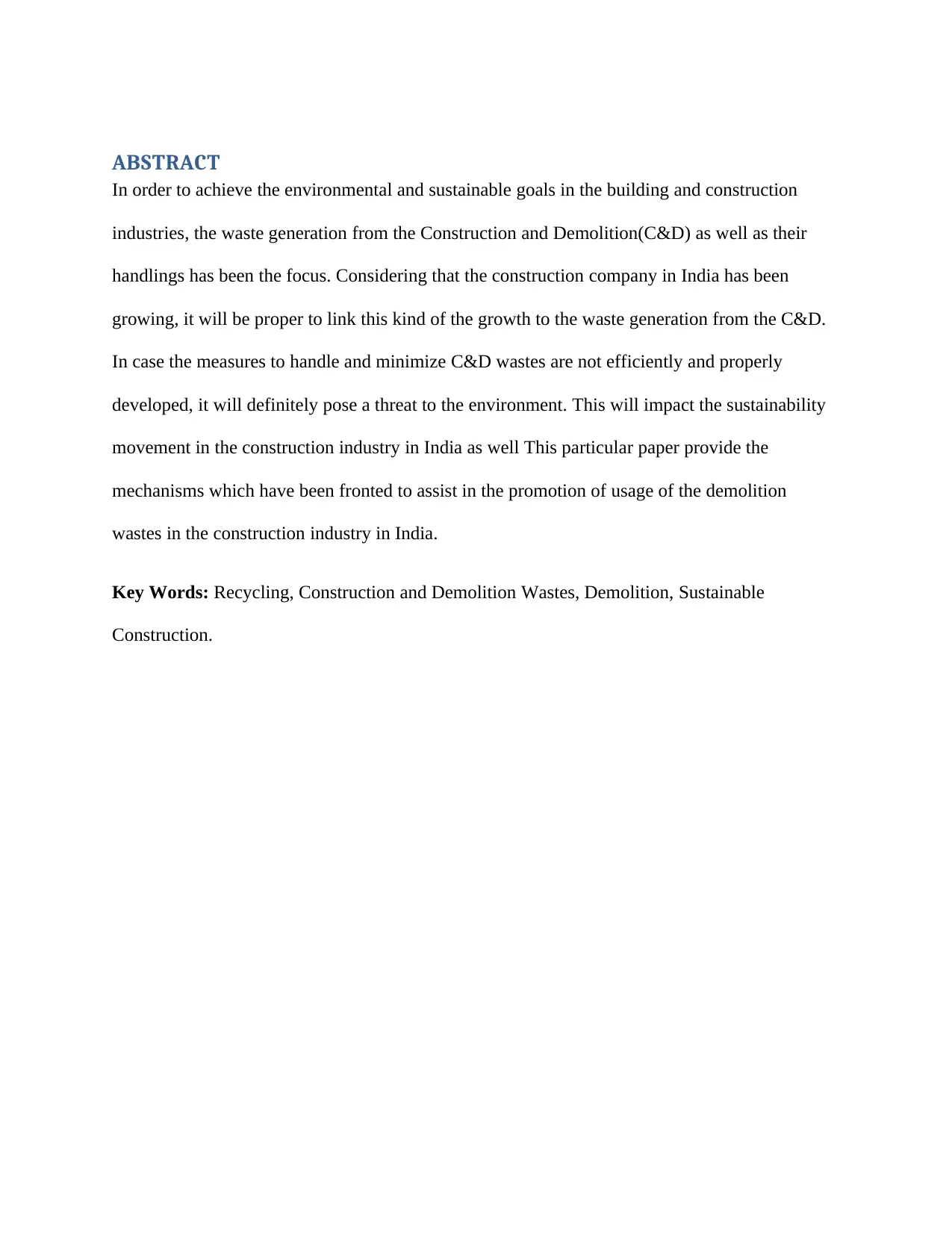
ABSTRACT
In order to achieve the environmental and sustainable goals in the building and construction
industries, the waste generation from the Construction and Demolition(C&D) as well as their
handlings has been the focus. Considering that the construction company in India has been
growing, it will be proper to link this kind of the growth to the waste generation from the C&D.
In case the measures to handle and minimize C&D wastes are not efficiently and properly
developed, it will definitely pose a threat to the environment. This will impact the sustainability
movement in the construction industry in India as well This particular paper provide the
mechanisms which have been fronted to assist in the promotion of usage of the demolition
wastes in the construction industry in India.
Key Words: Recycling, Construction and Demolition Wastes, Demolition, Sustainable
Construction.
In order to achieve the environmental and sustainable goals in the building and construction
industries, the waste generation from the Construction and Demolition(C&D) as well as their
handlings has been the focus. Considering that the construction company in India has been
growing, it will be proper to link this kind of the growth to the waste generation from the C&D.
In case the measures to handle and minimize C&D wastes are not efficiently and properly
developed, it will definitely pose a threat to the environment. This will impact the sustainability
movement in the construction industry in India as well This particular paper provide the
mechanisms which have been fronted to assist in the promotion of usage of the demolition
wastes in the construction industry in India.
Key Words: Recycling, Construction and Demolition Wastes, Demolition, Sustainable
Construction.

List of Tables
Table 1: ……………………………..Table showing the total amount of wasted materials in the
process of construction.
Table 2: ……………………………….Table showing term of service for construction elements
when applied in various construction processes
Table 3: ………………………………..A table showing the reported estimates for the consumption
amounts of concrete and cement.
Table 4: …………………………………Summary of the interviewed companies and
professionals
Table 5:………………………………………. Interviews Responses/Results
List of Figures
Figure 1: ……………………………………………Figure showing the flow of materials during
the operations that can be surpassed by structures like bridges, roads, buildings and many other
during the time of their existence.
Contents
ABSTRACT....................................................................................................................................................2
List of Tables........................................................................................................................................3
List of Figures.......................................................................................................................................3
INTRODUCTION...........................................................................................................................................3
Table 1: ……………………………..Table showing the total amount of wasted materials in the
process of construction.
Table 2: ……………………………….Table showing term of service for construction elements
when applied in various construction processes
Table 3: ………………………………..A table showing the reported estimates for the consumption
amounts of concrete and cement.
Table 4: …………………………………Summary of the interviewed companies and
professionals
Table 5:………………………………………. Interviews Responses/Results
List of Figures
Figure 1: ……………………………………………Figure showing the flow of materials during
the operations that can be surpassed by structures like bridges, roads, buildings and many other
during the time of their existence.
Contents
ABSTRACT....................................................................................................................................................2
List of Tables........................................................................................................................................3
List of Figures.......................................................................................................................................3
INTRODUCTION...........................................................................................................................................3
⊘ This is a preview!⊘
Do you want full access?
Subscribe today to unlock all pages.

Trusted by 1+ million students worldwide
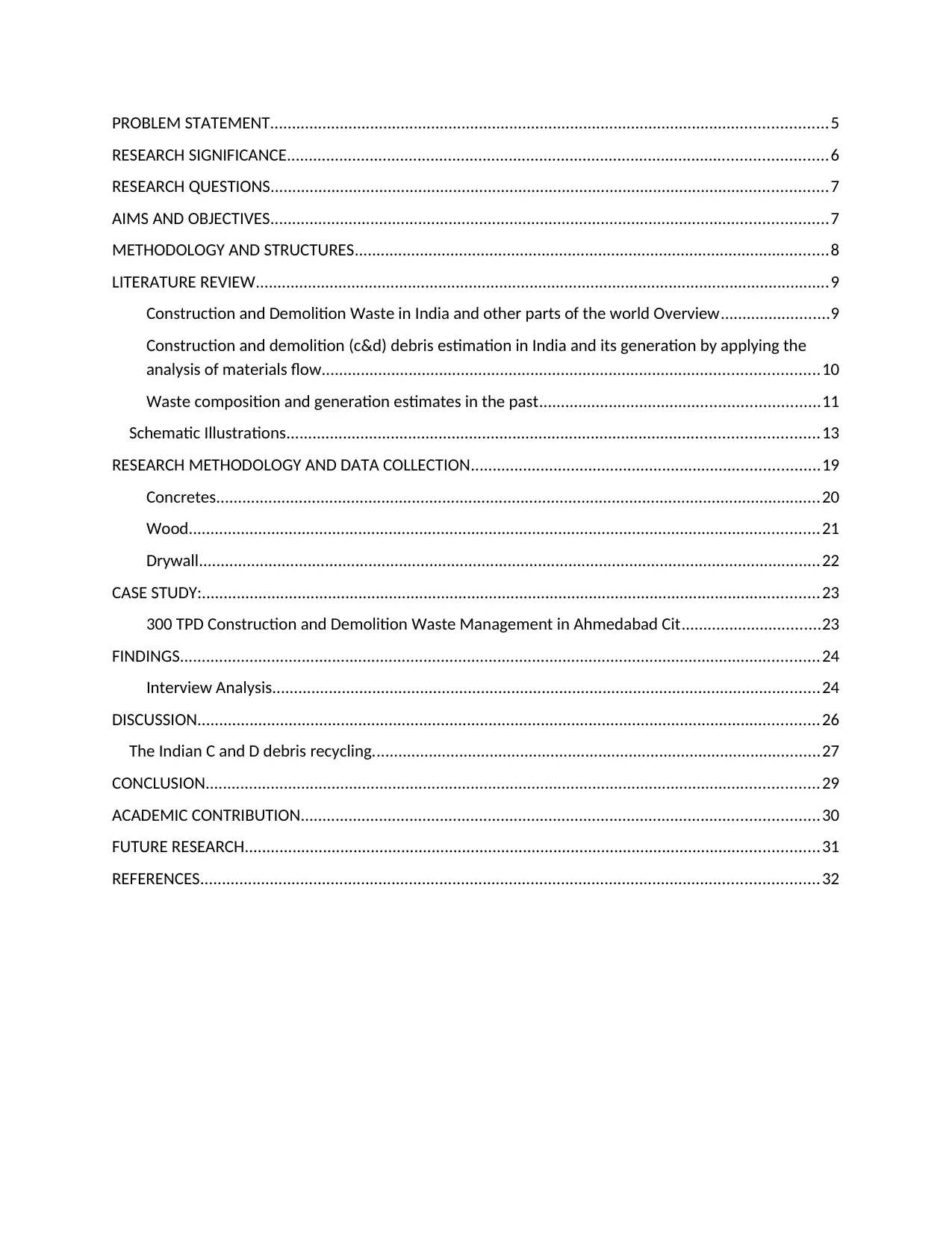
PROBLEM STATEMENT................................................................................................................................5
RESEARCH SIGNIFICANCE............................................................................................................................6
RESEARCH QUESTIONS................................................................................................................................7
AIMS AND OBJECTIVES................................................................................................................................7
METHODOLOGY AND STRUCTURES.............................................................................................................8
LITERATURE REVIEW....................................................................................................................................9
Construction and Demolition Waste in India and other parts of the world Overview.........................9
Construction and demolition (c&d) debris estimation in India and its generation by applying the
analysis of materials flow..................................................................................................................10
Waste composition and generation estimates in the past................................................................11
Schematic Illustrations..........................................................................................................................13
RESEARCH METHODOLOGY AND DATA COLLECTION................................................................................19
Concretes...........................................................................................................................................20
Wood.................................................................................................................................................21
Drywall...............................................................................................................................................22
CASE STUDY:..............................................................................................................................................23
300 TPD Construction and Demolition Waste Management in Ahmedabad Cit................................23
FINDINGS...................................................................................................................................................24
Interview Analysis..............................................................................................................................24
DISCUSSION...............................................................................................................................................26
The Indian C and D debris recycling.......................................................................................................27
CONCLUSION.............................................................................................................................................29
ACADEMIC CONTRIBUTION.......................................................................................................................30
FUTURE RESEARCH....................................................................................................................................31
REFERENCES..............................................................................................................................................32
RESEARCH SIGNIFICANCE............................................................................................................................6
RESEARCH QUESTIONS................................................................................................................................7
AIMS AND OBJECTIVES................................................................................................................................7
METHODOLOGY AND STRUCTURES.............................................................................................................8
LITERATURE REVIEW....................................................................................................................................9
Construction and Demolition Waste in India and other parts of the world Overview.........................9
Construction and demolition (c&d) debris estimation in India and its generation by applying the
analysis of materials flow..................................................................................................................10
Waste composition and generation estimates in the past................................................................11
Schematic Illustrations..........................................................................................................................13
RESEARCH METHODOLOGY AND DATA COLLECTION................................................................................19
Concretes...........................................................................................................................................20
Wood.................................................................................................................................................21
Drywall...............................................................................................................................................22
CASE STUDY:..............................................................................................................................................23
300 TPD Construction and Demolition Waste Management in Ahmedabad Cit................................23
FINDINGS...................................................................................................................................................24
Interview Analysis..............................................................................................................................24
DISCUSSION...............................................................................................................................................26
The Indian C and D debris recycling.......................................................................................................27
CONCLUSION.............................................................................................................................................29
ACADEMIC CONTRIBUTION.......................................................................................................................30
FUTURE RESEARCH....................................................................................................................................31
REFERENCES..............................................................................................................................................32
Paraphrase This Document
Need a fresh take? Get an instant paraphrase of this document with our AI Paraphraser

INTRODUCTION
The industry of the construction has been identified to be the main contributor to the generation
of the solid waste in the whole world. The surveys which hence been carried out in most parts of
the world particular in countries like India have shown that the generated solid waste from the
construction industry is equivalent to about 20% to 30 % of the entire waste which entire the
landfill from various sectors. The accumulation of the solid wastes and how to generally manage
the C%D wastes is currently becoming a bigger challenge or concern to the builders and the
town planners. This challenge has perpetuated the damping site shortage, increase the cost of the
conveyance and disposal costs and finally it has led to the increase in the pollution as well as
deterioration of the environment.
The construction and demolition waste which is commonly known as CDW usually arises from
construction activities in the case of thee civil infrastructure, partial or total demolition of the
civil infrastructure or buildings, planning and maintenance of the road among others. In India,
even the wastes from the leveling of land are usually regarded to be part of the demolition waste.
The undesirable effects of the C%D wastes started when their dumping were being done in the
streams, forests, rivers and parts of the empty land leading to tye contamination of the water
bodies, water tables and wells (Thomas and Wilson 2013)
The research work has estimated the total amount of the waste from the construction industry in
the form of solid to be about 1.3 billion tonnes every year. The volume of the solid wastes from
the construction industry is expected to increase to 2.2 billion by the year 2025 according to the
reports given by the World Bank. The materials of the building accounts for nearly half of all the
used objects and also half of the generated solid waste worldwide. In India alone, the
The industry of the construction has been identified to be the main contributor to the generation
of the solid waste in the whole world. The surveys which hence been carried out in most parts of
the world particular in countries like India have shown that the generated solid waste from the
construction industry is equivalent to about 20% to 30 % of the entire waste which entire the
landfill from various sectors. The accumulation of the solid wastes and how to generally manage
the C%D wastes is currently becoming a bigger challenge or concern to the builders and the
town planners. This challenge has perpetuated the damping site shortage, increase the cost of the
conveyance and disposal costs and finally it has led to the increase in the pollution as well as
deterioration of the environment.
The construction and demolition waste which is commonly known as CDW usually arises from
construction activities in the case of thee civil infrastructure, partial or total demolition of the
civil infrastructure or buildings, planning and maintenance of the road among others. In India,
even the wastes from the leveling of land are usually regarded to be part of the demolition waste.
The undesirable effects of the C%D wastes started when their dumping were being done in the
streams, forests, rivers and parts of the empty land leading to tye contamination of the water
bodies, water tables and wells (Thomas and Wilson 2013)
The research work has estimated the total amount of the waste from the construction industry in
the form of solid to be about 1.3 billion tonnes every year. The volume of the solid wastes from
the construction industry is expected to increase to 2.2 billion by the year 2025 according to the
reports given by the World Bank. The materials of the building accounts for nearly half of all the
used objects and also half of the generated solid waste worldwide. In India alone, the
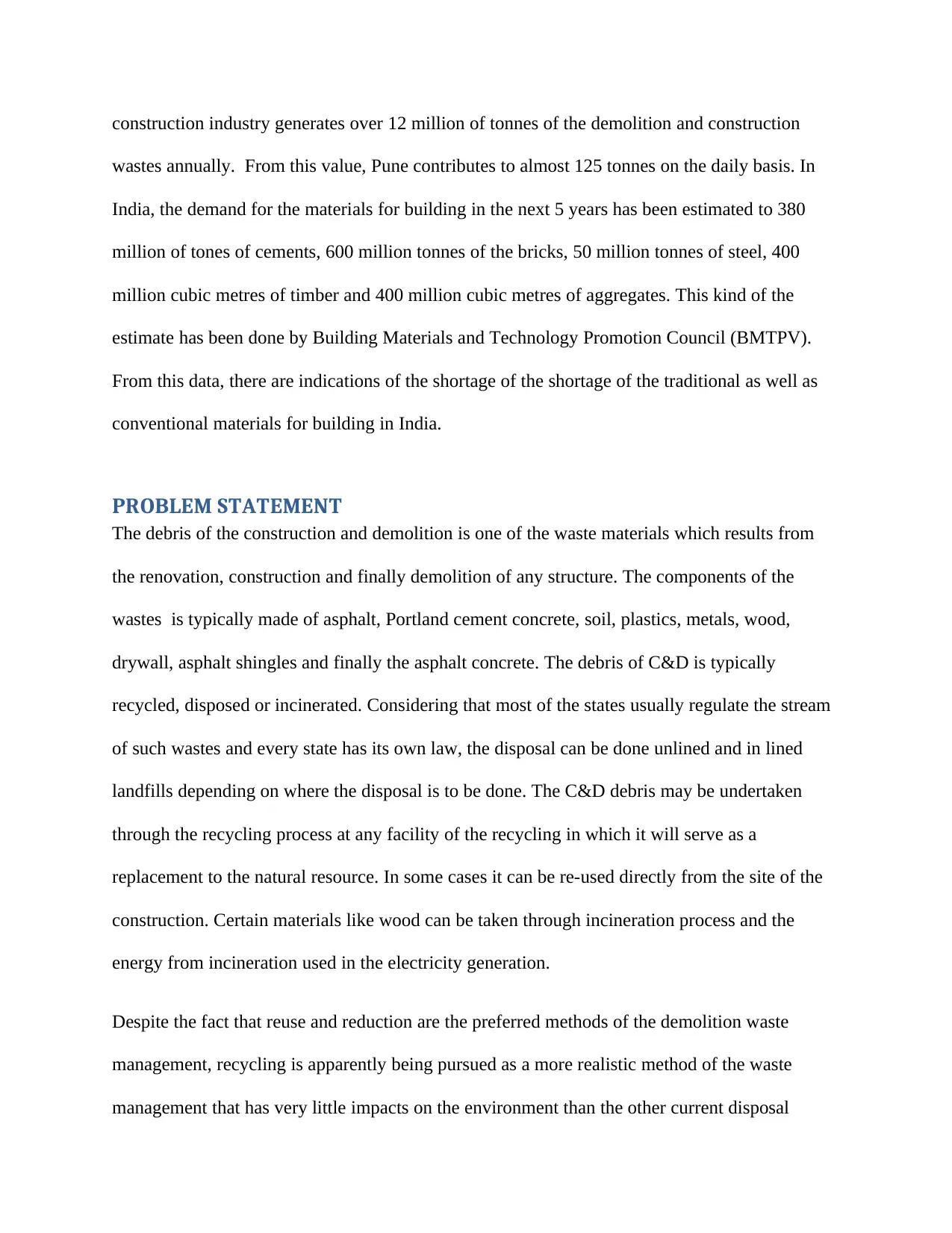
construction industry generates over 12 million of tonnes of the demolition and construction
wastes annually. From this value, Pune contributes to almost 125 tonnes on the daily basis. In
India, the demand for the materials for building in the next 5 years has been estimated to 380
million of tones of cements, 600 million tonnes of the bricks, 50 million tonnes of steel, 400
million cubic metres of timber and 400 million cubic metres of aggregates. This kind of the
estimate has been done by Building Materials and Technology Promotion Council (BMTPV).
From this data, there are indications of the shortage of the shortage of the traditional as well as
conventional materials for building in India.
PROBLEM STATEMENT
The debris of the construction and demolition is one of the waste materials which results from
the renovation, construction and finally demolition of any structure. The components of the
wastes is typically made of asphalt, Portland cement concrete, soil, plastics, metals, wood,
drywall, asphalt shingles and finally the asphalt concrete. The debris of C&D is typically
recycled, disposed or incinerated. Considering that most of the states usually regulate the stream
of such wastes and every state has its own law, the disposal can be done unlined and in lined
landfills depending on where the disposal is to be done. The C&D debris may be undertaken
through the recycling process at any facility of the recycling in which it will serve as a
replacement to the natural resource. In some cases it can be re-used directly from the site of the
construction. Certain materials like wood can be taken through incineration process and the
energy from incineration used in the electricity generation.
Despite the fact that reuse and reduction are the preferred methods of the demolition waste
management, recycling is apparently being pursued as a more realistic method of the waste
management that has very little impacts on the environment than the other current disposal
wastes annually. From this value, Pune contributes to almost 125 tonnes on the daily basis. In
India, the demand for the materials for building in the next 5 years has been estimated to 380
million of tones of cements, 600 million tonnes of the bricks, 50 million tonnes of steel, 400
million cubic metres of timber and 400 million cubic metres of aggregates. This kind of the
estimate has been done by Building Materials and Technology Promotion Council (BMTPV).
From this data, there are indications of the shortage of the shortage of the traditional as well as
conventional materials for building in India.
PROBLEM STATEMENT
The debris of the construction and demolition is one of the waste materials which results from
the renovation, construction and finally demolition of any structure. The components of the
wastes is typically made of asphalt, Portland cement concrete, soil, plastics, metals, wood,
drywall, asphalt shingles and finally the asphalt concrete. The debris of C&D is typically
recycled, disposed or incinerated. Considering that most of the states usually regulate the stream
of such wastes and every state has its own law, the disposal can be done unlined and in lined
landfills depending on where the disposal is to be done. The C&D debris may be undertaken
through the recycling process at any facility of the recycling in which it will serve as a
replacement to the natural resource. In some cases it can be re-used directly from the site of the
construction. Certain materials like wood can be taken through incineration process and the
energy from incineration used in the electricity generation.
Despite the fact that reuse and reduction are the preferred methods of the demolition waste
management, recycling is apparently being pursued as a more realistic method of the waste
management that has very little impacts on the environment than the other current disposal
⊘ This is a preview!⊘
Do you want full access?
Subscribe today to unlock all pages.

Trusted by 1+ million students worldwide
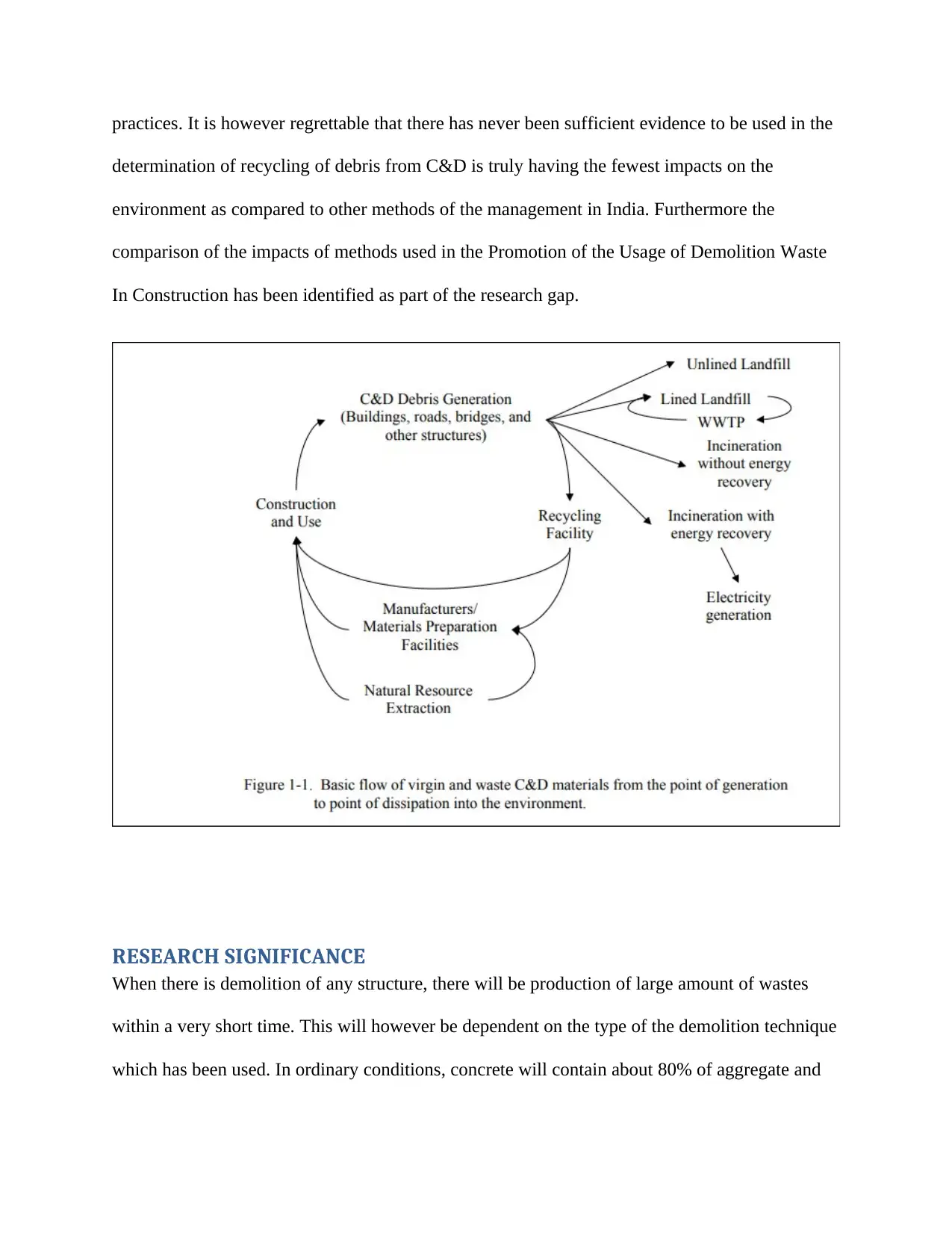
practices. It is however regrettable that there has never been sufficient evidence to be used in the
determination of recycling of debris from C&D is truly having the fewest impacts on the
environment as compared to other methods of the management in India. Furthermore the
comparison of the impacts of methods used in the Promotion of the Usage of Demolition Waste
In Construction has been identified as part of the research gap.
RESEARCH SIGNIFICANCE
When there is demolition of any structure, there will be production of large amount of wastes
within a very short time. This will however be dependent on the type of the demolition technique
which has been used. In ordinary conditions, concrete will contain about 80% of aggregate and
determination of recycling of debris from C&D is truly having the fewest impacts on the
environment as compared to other methods of the management in India. Furthermore the
comparison of the impacts of methods used in the Promotion of the Usage of Demolition Waste
In Construction has been identified as part of the research gap.
RESEARCH SIGNIFICANCE
When there is demolition of any structure, there will be production of large amount of wastes
within a very short time. This will however be dependent on the type of the demolition technique
which has been used. In ordinary conditions, concrete will contain about 80% of aggregate and
Paraphrase This Document
Need a fresh take? Get an instant paraphrase of this document with our AI Paraphraser

12% cement by mass. This implies that globally, there is consumption of gravel, sand, crushed
rocks at the approximated rate of 10 to 1 billion tones every year. The transport, processing and
mining operations usually involve such large quantities of the aggregate which are consumed
with considerable amount of energy. The presence or location in specific points is known to
affect the ecology very adversely particularly the forested areas and riverbed. This implies that
there is urgent need for the establishment of the proper waste management in such cases.
Similarly, while considering the infrastructure of India in the future which continues to expand, a
lot of waste will be generated and this will further call for the proper management of the wastes
of the construction and demolition which definitely rise (Kumar and Pandit 2013).
RESEARCH QUESTIONS
What are the potential sources of the solid wastes? Are the solid wastes generated from
buildings alone or other infrastructure as well? What classification is used?
What are the currently available systems of the demolition and construction waste
management in India?
What are the projected impacts of the solid waste from the demolitions of the civil
structures in India in the years to come?
AIMS AND OBJECTIVES
To evaluate the effectiveness of material flow analysis in the estimation of the amount of
waste as well as composition of the generated waste in the case of the C&D debris in
India.
rocks at the approximated rate of 10 to 1 billion tones every year. The transport, processing and
mining operations usually involve such large quantities of the aggregate which are consumed
with considerable amount of energy. The presence or location in specific points is known to
affect the ecology very adversely particularly the forested areas and riverbed. This implies that
there is urgent need for the establishment of the proper waste management in such cases.
Similarly, while considering the infrastructure of India in the future which continues to expand, a
lot of waste will be generated and this will further call for the proper management of the wastes
of the construction and demolition which definitely rise (Kumar and Pandit 2013).
RESEARCH QUESTIONS
What are the potential sources of the solid wastes? Are the solid wastes generated from
buildings alone or other infrastructure as well? What classification is used?
What are the currently available systems of the demolition and construction waste
management in India?
What are the projected impacts of the solid waste from the demolitions of the civil
structures in India in the years to come?
AIMS AND OBJECTIVES
To evaluate the effectiveness of material flow analysis in the estimation of the amount of
waste as well as composition of the generated waste in the case of the C&D debris in
India.
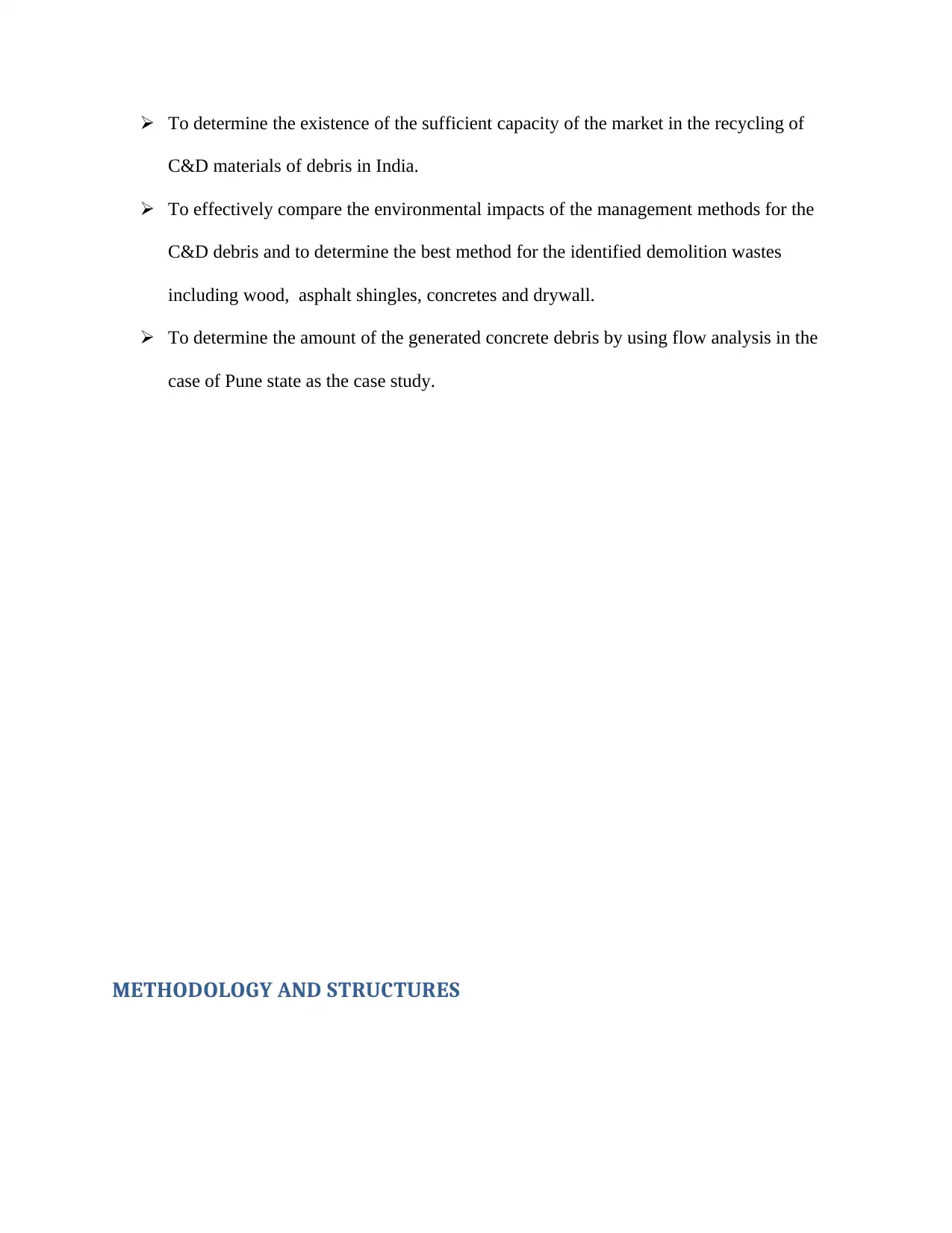
To determine the existence of the sufficient capacity of the market in the recycling of
C&D materials of debris in India.
To effectively compare the environmental impacts of the management methods for the
C&D debris and to determine the best method for the identified demolition wastes
including wood, asphalt shingles, concretes and drywall.
To determine the amount of the generated concrete debris by using flow analysis in the
case of Pune state as the case study.
METHODOLOGY AND STRUCTURES
C&D materials of debris in India.
To effectively compare the environmental impacts of the management methods for the
C&D debris and to determine the best method for the identified demolition wastes
including wood, asphalt shingles, concretes and drywall.
To determine the amount of the generated concrete debris by using flow analysis in the
case of Pune state as the case study.
METHODOLOGY AND STRUCTURES
⊘ This is a preview!⊘
Do you want full access?
Subscribe today to unlock all pages.

Trusted by 1+ million students worldwide
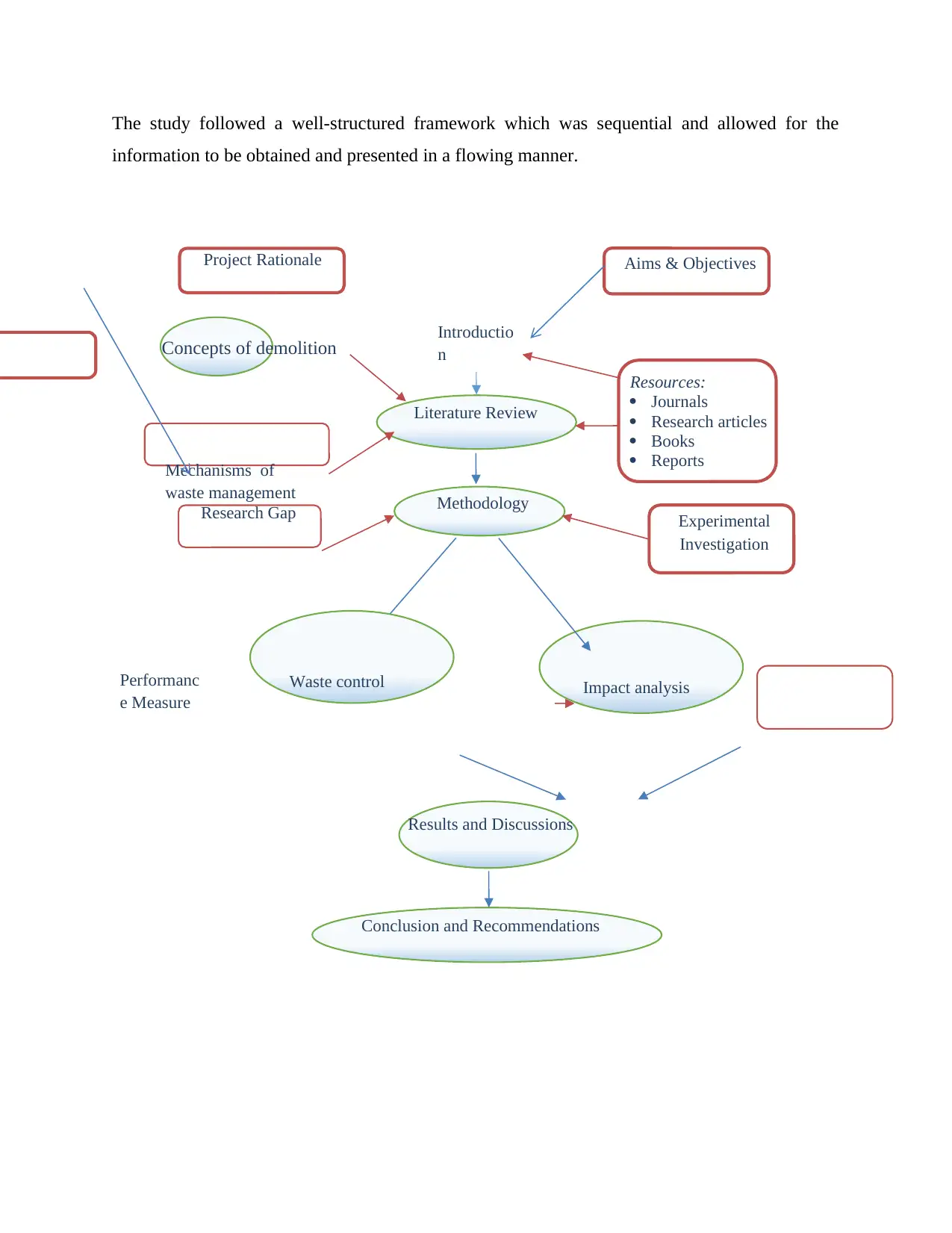
The study followed a well-structured framework which was sequential and allowed for the
information to be obtained and presented in a flowing manner.
Introductio
n
Literature Review
Methodology
Conclusion and Recommendations
Results and Discussions
Impact analysis
Aims & Objectives
Concepts of demolition
Resources:
Journals
Research articles
Books
Reports
Project Rationale
Experimental
Investigation
Mechanisms of
waste management
Research Gap
Waste controlPerformanc
e Measure
information to be obtained and presented in a flowing manner.
Introductio
n
Literature Review
Methodology
Conclusion and Recommendations
Results and Discussions
Impact analysis
Aims & Objectives
Concepts of demolition
Resources:
Journals
Research articles
Books
Reports
Project Rationale
Experimental
Investigation
Mechanisms of
waste management
Research Gap
Waste controlPerformanc
e Measure
Paraphrase This Document
Need a fresh take? Get an instant paraphrase of this document with our AI Paraphraser

LITERATURE REVIEW
Construction and Demolition Waste in India and other parts of the world Overview
Construction and Demolition wastes refers to the wastes which comprises debris, building
materials and rubbles which usually results from re-modeling, construction, demolition or repair
of any structure of the civil. There are rules which apply to each and every waste which comes
from the demolition, construction, re-modelling and repair of the civil structure of any
organization. It is important to note that construction has never been eco-friendly activity in
nature. The rising rate of the construction industry in India is rising at 10% every year. This is
the same rate which is reflected on the wastes of the construction (Bagdi, Aggarwal and Sherwal
2013).
In the year 2000 there was a survey which was conducted by TIFAC. According to the results of
this survey, the total amount of wastes which is generated from the industry of the construction
was estimated to be between 12 to 14.7 million tons per year. This included bitumen, bricks,
sand, gravel, concrete and masonry. Although there are no current statistics on the same, it has
been approximated that the daily waste generation in India from the C&D industries stagnates at
300000tonnes. The generation of the wastes usually takes place at various processes of the
construction. The estimated generation of wastes during the process of the construction has been
taken to be between 40 to 60 kg for every square metres. Also the waste generation during the
repair or renovation is between 40 to 50 kg for every square metres. The highest contribution to
the generation of the wastes is as a result of the processes of the demolition. However, there is no
satisfactory data or adequate data for accessing the same issue (Pandey et al 2016).
Construction and Demolition Waste in India and other parts of the world Overview
Construction and Demolition wastes refers to the wastes which comprises debris, building
materials and rubbles which usually results from re-modeling, construction, demolition or repair
of any structure of the civil. There are rules which apply to each and every waste which comes
from the demolition, construction, re-modelling and repair of the civil structure of any
organization. It is important to note that construction has never been eco-friendly activity in
nature. The rising rate of the construction industry in India is rising at 10% every year. This is
the same rate which is reflected on the wastes of the construction (Bagdi, Aggarwal and Sherwal
2013).
In the year 2000 there was a survey which was conducted by TIFAC. According to the results of
this survey, the total amount of wastes which is generated from the industry of the construction
was estimated to be between 12 to 14.7 million tons per year. This included bitumen, bricks,
sand, gravel, concrete and masonry. Although there are no current statistics on the same, it has
been approximated that the daily waste generation in India from the C&D industries stagnates at
300000tonnes. The generation of the wastes usually takes place at various processes of the
construction. The estimated generation of wastes during the process of the construction has been
taken to be between 40 to 60 kg for every square metres. Also the waste generation during the
repair or renovation is between 40 to 50 kg for every square metres. The highest contribution to
the generation of the wastes is as a result of the processes of the demolition. However, there is no
satisfactory data or adequate data for accessing the same issue (Pandey et al 2016).
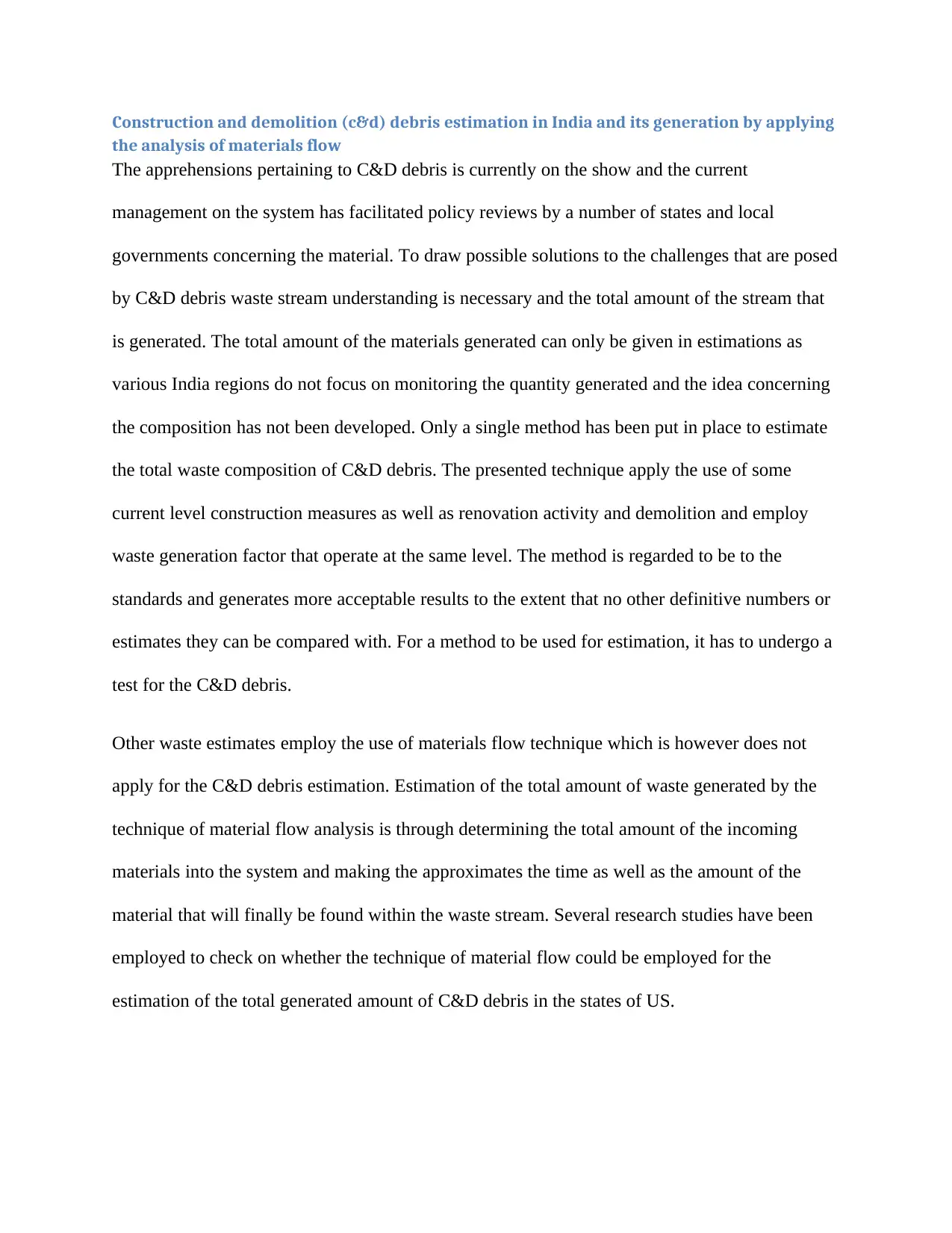
Construction and demolition (c&d) debris estimation in India and its generation by applying
the analysis of materials flow
The apprehensions pertaining to C&D debris is currently on the show and the current
management on the system has facilitated policy reviews by a number of states and local
governments concerning the material. To draw possible solutions to the challenges that are posed
by C&D debris waste stream understanding is necessary and the total amount of the stream that
is generated. The total amount of the materials generated can only be given in estimations as
various India regions do not focus on monitoring the quantity generated and the idea concerning
the composition has not been developed. Only a single method has been put in place to estimate
the total waste composition of C&D debris. The presented technique apply the use of some
current level construction measures as well as renovation activity and demolition and employ
waste generation factor that operate at the same level. The method is regarded to be to the
standards and generates more acceptable results to the extent that no other definitive numbers or
estimates they can be compared with. For a method to be used for estimation, it has to undergo a
test for the C&D debris.
Other waste estimates employ the use of materials flow technique which is however does not
apply for the C&D debris estimation. Estimation of the total amount of waste generated by the
technique of material flow analysis is through determining the total amount of the incoming
materials into the system and making the approximates the time as well as the amount of the
material that will finally be found within the waste stream. Several research studies have been
employed to check on whether the technique of material flow could be employed for the
estimation of the total generated amount of C&D debris in the states of US.
the analysis of materials flow
The apprehensions pertaining to C&D debris is currently on the show and the current
management on the system has facilitated policy reviews by a number of states and local
governments concerning the material. To draw possible solutions to the challenges that are posed
by C&D debris waste stream understanding is necessary and the total amount of the stream that
is generated. The total amount of the materials generated can only be given in estimations as
various India regions do not focus on monitoring the quantity generated and the idea concerning
the composition has not been developed. Only a single method has been put in place to estimate
the total waste composition of C&D debris. The presented technique apply the use of some
current level construction measures as well as renovation activity and demolition and employ
waste generation factor that operate at the same level. The method is regarded to be to the
standards and generates more acceptable results to the extent that no other definitive numbers or
estimates they can be compared with. For a method to be used for estimation, it has to undergo a
test for the C&D debris.
Other waste estimates employ the use of materials flow technique which is however does not
apply for the C&D debris estimation. Estimation of the total amount of waste generated by the
technique of material flow analysis is through determining the total amount of the incoming
materials into the system and making the approximates the time as well as the amount of the
material that will finally be found within the waste stream. Several research studies have been
employed to check on whether the technique of material flow could be employed for the
estimation of the total generated amount of C&D debris in the states of US.
⊘ This is a preview!⊘
Do you want full access?
Subscribe today to unlock all pages.

Trusted by 1+ million students worldwide
1 out of 36
Related Documents
Your All-in-One AI-Powered Toolkit for Academic Success.
+13062052269
info@desklib.com
Available 24*7 on WhatsApp / Email
![[object Object]](/_next/static/media/star-bottom.7253800d.svg)
Unlock your academic potential
Copyright © 2020–2025 A2Z Services. All Rights Reserved. Developed and managed by ZUCOL.





